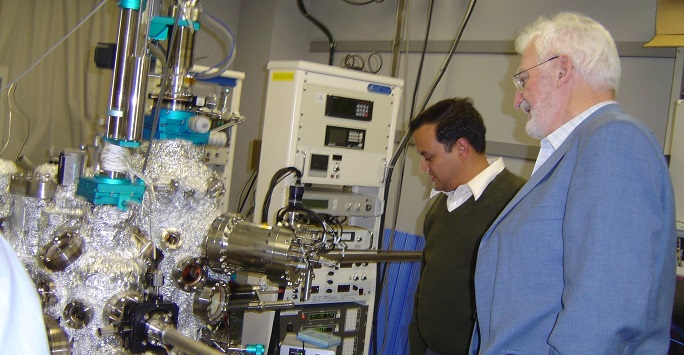Dr Hem Raj Sharma
Senior Lecturer in Physics, Hem Raj Sharma, specialises in condensed matter physics, focusing on atomic-scale characterisation of complex metallic alloys and quasicrystals. Their research supports advancements in nanoscale science, thin film growths, catalysis, and corrosion resistance.
Born – Baglung, Nepal
PhD – Free University Berlin, Germany
Joined University of Liverpool – 2007
Position – Senior Lecturer, Department of Physics
Group Name – Quasicrystal Research Group

What is your research about?
My research is in the field of condensed matter physics and materials science, in particular, atomic scale characterisation of surfaces of complex metallic alloys, including quasicrystals – solids with unconventional symmetries. Understanding atomic scale characteristics of these materials is important for optimizing their properties relevant to technological applications in various areas such as nanoscale science, thin film growths, catalysis, and corrosion resistance.
What or who first inspired you to be interested in your research subject?
One of my strongest areas of interest in undergraduate study was solid state physics. After completing undergraduate education in Nepal, I got an opportunity to join Rikkyo University in Japan as a research student. Subsequently, I completed a postgraduate diploma in condensed matter physics from the International Centre for Theoretical Physics (ICTP) in Italy.
The ICTP diploma program was designed to bridge the physics knowledge gap between students educated in underdeveloped and developed countries. I received a unique opportunity to learn from world leading scientists in the field. The knowledge acquired at the distinct forum of ICTP and research experience garnered at the world-class research institution in Japan boosted my confidence in further education and research, and inspired the selection of my current field of research.
What are you most proud of achieving during your research career so far?
As a child, I never imagined that I would leave Nepal and be involved in physics research. I was born and raised in a remote mountainous village of Nepal. We did not have basic facilities of clean running water and electricity, and I needed to walk about two hours each day to attend school. Considering my childhood circumstances, I am proud of every mile of success I have been able to traverse. I have established a very good international network of experts in my field, and enjoy working with PhD and undergraduate students who join our research group from the UK, European Union and worldwide.
What techniques and equipment do you use to conduct your research?
I am an experimental physicist. I use the various surface science techniques such as scanning tunnelling microscopy, low energy electron diffraction, and x-ray photoemission spectroscopy that available in our lab within my research. We also use experimental tools available at other research facilities of European Integrated Centre for the Development of New Metallic Alloys and Compounds (ECMetAC), of which we are a member. We obtain research samples from our collaborators from ECMetAC and research groups from other countries.
What is the key to running a successful research group?
International collaboration is vital for my research. The experimental samples we use for our research are commercially unavailable so we rely on our collaborators to obtain quality samples. We also collaborate with theoretical research groups to complement our experimental results.
Teamwork is also central to my research. Mutual respect and developing an understanding of fellow group members are key factors for a successful team. I often work in a group comprised of members from all around the world, so understanding their work cultures is also vital. Above all, maintaining high academic standards among the group members is very important.
What impact is your research having outside of academia?
My research is focused mainly on the fundamental understanding of materials. The application of scientific knowledge beyond academia goes through a long process in which the accumulation of a sufficient amount of vetted scientific information needs to be gathered. Slowly but surely, fundamental knowledge gained through my research will be useful for technological applications in areas such as nanoscale science, thin film growths, catalysis, and corrosion resistance, which have implications across a wide range of industries and sectors.
How do you plan to develop your research in the future?
Over the last decade, we were successful in growing novel overlayer structures on surfaces of quasicrystals such as quasicrystalline monolayer of C60 and Pentacene molecules, and multilayer quasicrystalline structure of lead. These materials are naturally periodic, but the underlying quasicrystalline surface facilitates them to grow in unusual form of structure. These structures are beautiful, but their atomic-scale characterization using common experimental techniques is challenging.
Inspired by their intriguing structure in atomic scale, going forward we want to realize multiscale quasicrystalline structures using additive manufacturing techniques in collaboration with engineering research groups. These multiscale structures will be useful in understanding the origin of novel properties of materials having unconventional crystallographic symmetries, and in finding a pathway for industrial application of these materials.
What advice would you give to someone considering a career in research?
Research requires patience, dedication and hard work, but it is a highly rewarding career. It provides opportunity to be connected to world experts, and exchange ideas and knowledge. A beautiful aspect of research life is the freedom and opportunity to implement our ideas and better understanding nature. Depending upon the field of research, you may get a chance to make an impact on everyday life of people too.
I was born and raised in a remote mountainous village of Nepal. As a child, I never imagined that I would leave Nepal and be involved in physics research.